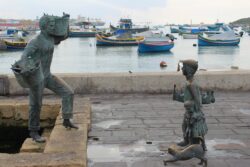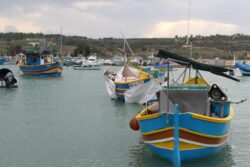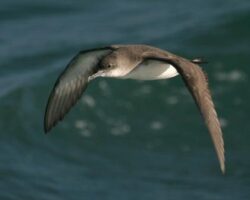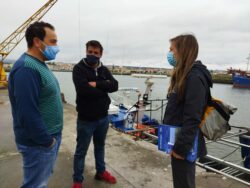Enjoy eating fish and also love marine wildlife? You’re not alone. Did you know about some of the problems faced by seabirds as a result of the fishing industry? Want to learn more about our work and how you can eat fish sustainably? Read on.
The Mediterranean has long been a source of seafood for the countries surrounding it, and consuming fish has shaped many of its cultures and traditions. Our LIFE PanPuffinus! project is working with local fishermen to research possible impacts on seabirds and to help develop safe practices, while respecting traditions.
Fish consumption worldwide
We consume 143.8 million tonnes of fish per year globally. That figure doesn’t even include other uses we have for seafood such as in cosmetics or pet food – and it keeps rising. The number of fish that people consume is increasing exponentially with a growing population and urbanisation. In the 60s, the average person consumed 9.9kg of fish per year – now that figure has risen to 20kg. The demand is definitely there.
And the EU?
The EU is the fifth largest producer of fishery and aquaculture products worldwide, covering 3% of global production in 2017. The main species caught are tuna, salmon, cod, pollock, hake and herring. Anchovy and sardines represent the most commonly caught species.
This is big business. The total value of fish landings in the Mediterranean is over €4 billion. In the years between 1990 and 2010, there was an increase of 160% in the total value of Mediterranean fisheries. It creates jobs too – around 250,000 people are employed in fisheries in the Mediterranean and Black Sea.
So, it’s clear we like our fish. What’s the problem?
In 2018, a report by the UN’s Food and Agriculture Organisation (FAO) stated that over a third of global marine fish populations were in decline. 85% of fish stocks in the Mediterranean are fished at unsustainable levels due to demand, resulting in a decline in many populations. Around 18% of total catches are discarded, with bottom trawlers being the most wasteful method.
This high volume of fishing effort and rate at which fisheries resources are being extracted, means that responsible management of fish stocks is crucial to ensure supply in the future. Such management will include not only the type of species being targeted, but also when and how it is fished.
What makes fisheries sustainable?
According to the Marine Stewardship Council (MSC), for a fishery to be considered sustainable it must meet three standards:
1. Fishing at a level in which populations are not declining and are productive and healthy.
2. Ensuring minimal impact to habitats and other species.
3. Well managed operations, complying with laws and adapting to changing environmental circumstances.
Once a fishery meets the above and is MSC-certified, it undergoes regular assessments to continuously improve its practise. Fishing quotas and closing seasons are in place once the quotas have been reached, ensuring sustainable practice.
How you can help
It is important that we support our local fishing industries and sustainable fishing practices and there are many ways you can do this at the individual level. Here’s some ideas:
- Eat seasonal fish which limits the demand for imported fish.
- Shop locally which means you are supporting local fishermen. Eating local has the added benefit of lowering your carbon footprint too.
- Eat a range of fish species, limiting the demand for particular species.
- Avoid eating fish that is caught by trawlers as this is the most unsustainable method. You can check the labels to see how it was caught or ask your local fishmonger or restaurant chef.
- Look for MSC-certified products and select these wherever you can.
- If you have a favourite fish that you eat regularly, do some research on its conservation status and consider similar options if populations are in decline.
- Resources like the Good Fish Guide and the Quickfish Guide can help you make informed decisions about what fish to eat.
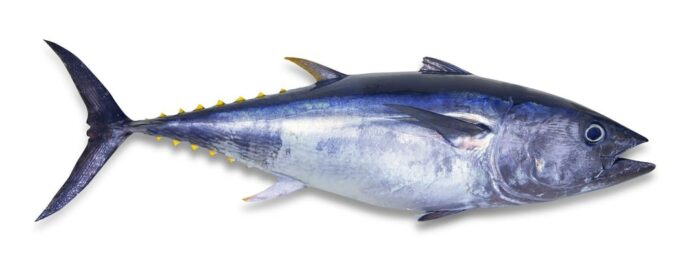
How does all this affect seabirds?
Competition exists between fisheries and seabirds – they are both in search of food. The seabirds are looking for an easy meal and are commonly seen following fishing vessels but, unfortunately, this doesn’t always end well for them.
Yelkouan Shearwaters, for example, are excellent fishers and exceptional divers – reaching depths of over 30 meters to catch fish. Unfortunately, this can result in them getting caught accidentally in hooks, lines and/or nets where they end up drowning or suffering from injuries.
Introducing LIFE PanPuffinus!
The LIFE PanPuffinus! project is run through BirdLife Malta and BirdLife partners from another four countries (France, Greece, Portugal, Spain), with the aim to protect and conserve two endemic and threatened Mediterranean seabirds: the Yelkouan and Balearic Shearwater. Transboundary conservation efforts across the Mediterranean and the Atlantic coast of Portugal are underway to tackle threats at land and at sea. The partnership will lead to the development of data monitoring and collection to improve conservation efforts and assess threats to minimise levels of impact.
How are we collaborating with local fishermen? What are we hoping to achieve?
The LIFE PanPuffinus! project aims to prevent the problem of seabird bycatch by working with fishers to create sustainable practices.
In order to find solutions, the LIFE PanPuffinus! project team are engaging with fishers. Working closely and following a community-led approach is critical for the success of species conservation projects such as this one. Portugal and Spain have done this in the past, for example, and have developed good relations with the fishermen for a mutually desired outcome.
One of the main objectives is to know where the interaction between seabirds and fisheries exists. Collecting information of the seabirds’ flight path and the routes taken by fishing vessels will be used to create maps to clearly show overlap of activity. This will allow us to focus on these areas to implement mitigation measures in order to decrease the risk of bycatch.
Follow our work to stay up to date with our project outcomes!
Read further links:
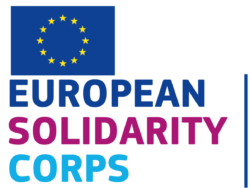
European Maritime and Fisheries Fund Malta factsheet
Mediterranean Fisheries and Aquaculture
By Belinda Hodder, BirdLife Malta Communications Assistant
Belinda Hodder is an Erasmus+ volunteer following a European Solidarity Corps programme

